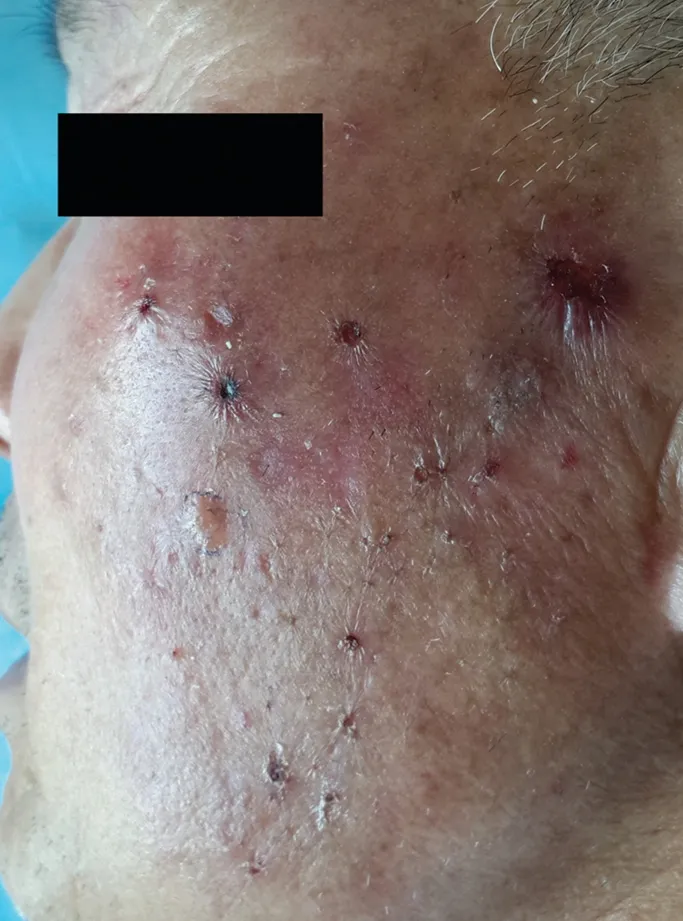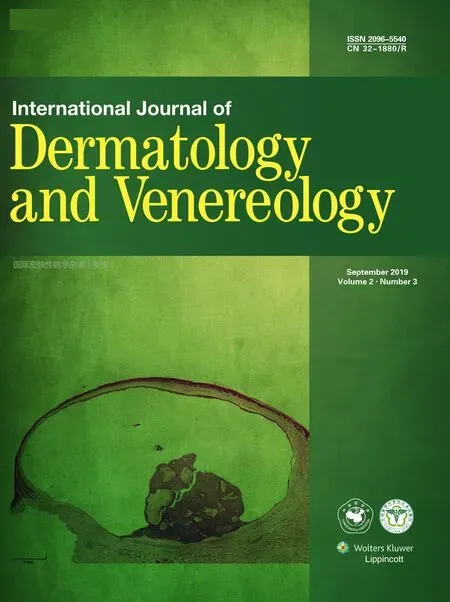Nasal Type Extranodal NK/T-Cell Lymphoma Presenting with Unilateral Facial Erythemas,Nodules, and Necrosis
Kunal Shah, Yi Sun∗, Tong-Xiang Zeng
Department of Dermatology, Jingzhou Central Hospital, The Second Clinical Medical College, Yangtze University, Jingzhou, Hubei 434100, China.
Introduction
Nasal type extranodal natural killer (NK)/T-cell lymphoma is an aggressive neoplasm that is recognized as an independent entity in the mature T-cell and NK neoplasm group according to the World Health Organization/European Organization for Research and Treatment of Cancer classification for cutaneous lymphomas.1-2It is usually seen in middle-aged and elderly people, most commonly presenting as destructive lesions in the nasal cavity and nasopharynx.2-3Here we present a case of nasal type extranodal NK/T-cell lymphoma presenting as left facial erythemas, nodules, and necrosis, with a history of another EB virus-associated neoplasms. We report this case due to its unique clinical characteristics from previous cases,in order to improve the knowledge of clinician about this disease.
Case report
A 78-year-old male patient presented with a seven-month history of progressive left facial erythemas, nodules, and necrosis. He had been diagnosed with nasopharyngeal carcinoma 13 years previously,and systemic radiotherapy and chemotherapy had been performed after surgical resection.A physical examination revealed unilateral erythemas and multiple nodules on the left side of his face with necrosis and incrustation (Fig. 1). A nasopharyngeal CT scan upon presentation showed the absence of the right middle turbinate and the presence of low-density lesions in the bilateral maxillary sinus and antrum-ethmoid bone.A biopsy of one nodule was performed, and routine hematoxylin-eosin staining (Fig. 2A and 2B) and immunochemistry for CD56 (Fig. 2C and 2D) were performed. The histopathology revealed infiltrating lymphocytes scattered or clustered in the dermis with a few plasmacytes. There were plenty of heteromorphic lymphoid cells around the vessels with pale or transparent cytoplasm,irregular nuclei of various sizes, and excessive chromatin; additionally, some cells had a few small nucleoli and appeared to be in the mitotic phase. The results of immunochemical staining for CD3ε, CD4,CD43, T-cell intracellular antigen-1 (TIA-1), and CD56(Fig. 2C and 2D) as well as those of in situ hybridization for EBER (Fig. 2E and 2F) were all positive.

Figure 1. Patient’s clinical presentation.Multiple erythemas,nodules,and necrosis on the face.

Figure 2. Histology of the nodule.A and B:Images of hematoxylin-eosin staining of one of the patient’s nodules.Infiltrating lymphocytes are scattered or clustered in the dermis(A:×100).Many heteromorphic lymphoid cells with pale or transparent cytoplasm,irregular nuclei of various sizes,and excessive chromatin are visible.Some cells display a few small nucleoli and mitotic phase(B:×400).C and D:Immunohistochemical result of CD56 detection (C: ×100; D: ×400). E and F: Immunohistochemical result of EBER detection (E: ×100; F: ×400).
These findings support the diagnosis of nasal type extranodal NK/T-cell lymphoma.After consultations with doctors from oncology and hematology, we proposed further examinations to define the stage of the lymphoma,but the patient refused.After symptomatic treatment with traditional Chinese medicine (details are unknown) for two months, the patient’s lesions improved somewhat.
Discussion
Nasal type extranodal NK/T-cell lymphoma is usually seen in middle-aged and elderly people and typically has a poor prognosis.2-3This condition has a strong association with Epstein-Barr virus infection.3For the treatment of a stage I/II disease, radiotherapy is recommended.4In addition,chemotherapy is also suggested for part patients with stage I/II, and it is the main treatment for a patient in stage III/IV.4The prognosis of nasal and non-nasal NK-cell lymphomas is predicted by the International Prognostic Index, circulating Epstein-Barr virus DNA level, and lactate dehydrogenase level.5-6Relapses of nasal and nonnasal NK-cell lymphoma usually occur within 2 years of complete remission,7but relapses after 29-38 years have also been reported.8-9
In conclusion,nasal type extranodal NK/T-cell lymphoma is an aggressive lymphoma with a poor prognosis.It always displays confusing cutaneous lesions, which require timely biopsy and close clinicopathological correlation. Immunohistochemical analysis is essential for an accurate diagnosis if the biopsy reveals an atypical lymphocyte infiltration.Radiotherapy alone or in combination with chemotherapy could improve the remission and survival rates.
Acknowledgements
This work was supported by the National Natural Science Foundation of China (No. 81401677 to Sun Y), and the Hubei Province Health and Family Planning Scientific Research Project (No. WJ2015MB281 to Sun Y).
- 国际皮肤性病学杂志的其它文章
- Solid-Cystic Hidradenoma
- Arteriosclerosis Obliterans Presenting as Multiple Leg Ulcers: A Case Report
- Interstitial Mycosis Fungoides with Systemic Sclerosis-Like Features: A Case Report
- Lentigines within Nevus Depigmentosus
- Subungual Exostosis Misdiagnosed as Subungual Wart
- Severe Port Wine Stain with Significant Nodules and Alveolar Bone Invasion Leading to Restricted Mouth Opening

